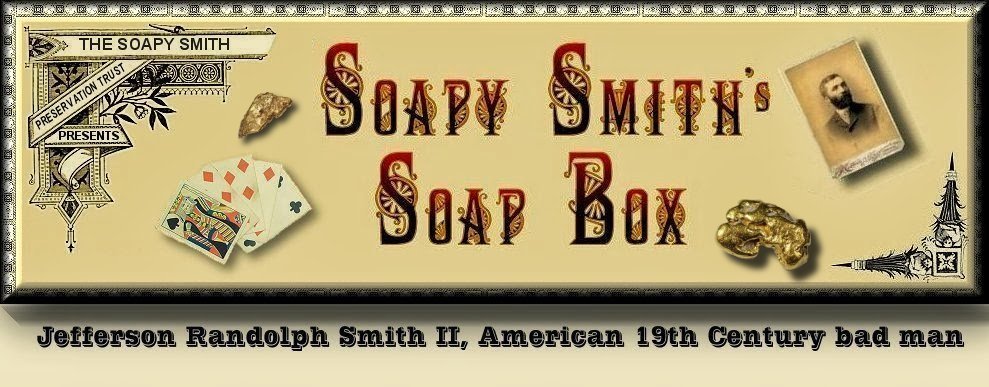 |
| Soapy Smith's final resting place The first of five grave markers placed over the grave (courtesy of Dickey Family Collection) |
arl Gurcke published a post entitled, A Very Brief History of Skagway Tourism, on Golden Nuggets, the official blog for the Klondike gold rush National Historic Park. It is a brief history of Skagway tourism.
Included in the story is the contents of the newspaper article which most likely explains what happened to the first marker on Soapy Smith's grave, and the date it went missing.
The following is from The Daily Alaskan, July 20, 1908
The headstone over the grave of "Soapy" Smith has been carried away—stolen. Jack Keller visited the grave yesterday and only a hole in the ground remained where he had seen the headstone at a visit on Wednesday last... The head piece was a simple wooden slab bearing the inscription: Jefferson R. Smith, aged 38. Died July 8, 1898. The grave is at the south edge of the Skagway burying ground and is largely overgrown with shrubbery. There has been a constant stream of visitors to the place all spring and summer evidencing the interest felt in the outlaw and the tragedy of his taking off. That there should be a vandal so foolish as to steal a gravestone that could not be shown to another without stamping the owner as a ghoulish vandal—that is to say thief—is one of the queer things we hear of as we travel the trail.
The marker was stolen sometime between July 15-20, 1908. Key to the story is that the marker removal left a hole (left there when pulling the marker out of the ground). The second grave marker (in my possession) is very roughly broken up along the bottom, meaning that it did not come out of the ground very easily. I am betting the bottom portion of the 2nd marker was left in the ground, not leaving "a hole" as the one reported in the newspaper article did. It is possible that the marker still exists, somewhere in someone's private collection, probably by a collector who has no idea who Jefferson Randolph Smith is.
All of Soapy's grave markers, and their known histories can be viewed on the main website (which is currently being revamped) here.
All of Soapy's grave markers, and their known histories can be viewed on the main website (which is currently being revamped) here.

Soapy Smith's grave markersNovember 21, 2008
June 20, 2009
September 3, 2009
May 21, 2011
May 28, 2011
May 6, 2012
October 9, 2012
March 6, 2013
"There are four kinds of Homicide: felonious,
excusable, justifiable, and praiseworthy."
—— Ambrose Bierce (1842-1914)
MAY 23
1785: Benjamin Franklin writes in a letter that he has invented bifocals.
1788: South Carolina becomes the eighth state to ratify U.S. Constitution.
1827: The first nursery school in the U.S. is established in New York City.
1846: Arabella Mansfield (Belle Aurelia Babb) is born. She is the first woman in the U.S. to pass the bar exam, though she never used her law degree.
1867: The outlaw James Gang robs the Hughs and Mason Bank in Richmond, Missouri of $4,000 in gold. The town’s mayor, the jailer and his son are killed in the process as other men are broken out of jail.
1868: Kit Carson dies during an operation in Fort Lyon, Colorado Territory, at age 59.
1872: The outlaw James-Younger gang robs a bank in Genevieve, Missouri of $4,000.
1873: The Canadian Parliament in Ottawa, Ontario passes a bill creating the North-West Mounted Police (NWMP); a military police like Royal Irish Constabulary, to patrol the border and to keep peace between Indians and traders. In 1920 they are merged with the Dominion Police to form the Royal Canadian Mounted Police (RCMP). During the Klondike gold Rush they did their best to keep Soapy Smith and the Soap Gang out of Canada.
1876: Boston’s Joe Borden pitches the first no-hitter in the history of the National League.
1879: The first U.S. veterinary school is established by Iowa State University.
1882: Convicted murderer, Jesse Evans, of Lincoln County War fame escapes while on a prison work exchange program and is never heard from again.
1895: The New York Public Library is created.
1900: Civil War hero Sergeant William Carney becomes the first African American to receive the Medal of Honor, 37 years after the Battle of Fort Wagner.
1901: American forces capture Filipino rebel leader Emilio Aguinaldo.





No comments:
Post a Comment
Thank you for leaving your comment and/or question on my blog. I always read, and will answer all questions asap. Please know that they are greatly appreciated. -Jeff Smith